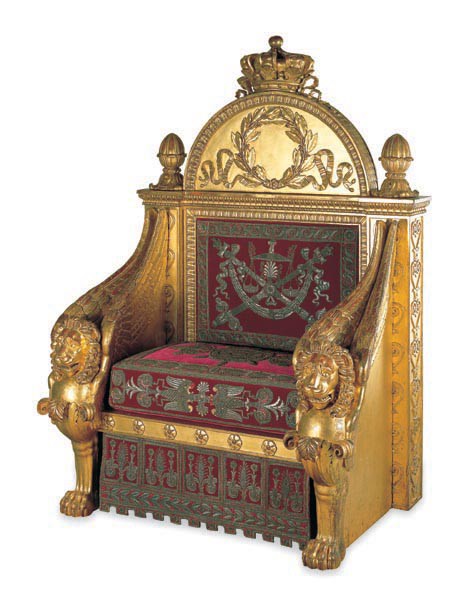If Napoleon's personal tastes were simple and reserved – his sober and functional campaign equipment attest to this fact -, the pomp and splendour that surrounded his regime were anything but. His imperial residences and official buildings were luxuriously furnished to give an image of wealth, grandeur and majesty. The Emperor's throne, the symbol of power par excellence, played an important role in this image.
In 1804, Percier and Fontaine were given the task of designing the decor and furnishings of the throne rooms at the Palais des Tuileries and Saint-Cloud, and, in 1807, for Fontainebleau as well. For the throne that sat in the Corps Législatif, however, it was Bernard Poyet who was approached. The latter was the architect behind the Palais Bourbon, where the assembly sat, and, in 1806, he was commissioned to design the building's new facade (the present Assemblée Nationale). A number of different models served as inspiration in Poyet's designs for the throne that the Emperor would occupy during sessions of the Corps Législatif. These included the famous examples known as the Bacchus and Ceres thrones, which were taken from the Vatican after the Treaty of Tolentino (February 1797) and which were put on display in the Galerie des Antiques in the Musée Napoléon, and the models designed by Percier and Fontaine. Poyet adapted these designs and added a curved pediment, framed by two eagles. He also removed the sculpted decoration on the sides, preferring instead a smooth wooden gilt, and replaced the back and seat of the throne with a rich, dark-red velour, embroidered with silver-thread motifs evoking Justice.
The Emperor's throne which sat in the Corps Législatif is distinct in its heavy, oversized form, the ostentatious nature of the gilded wood, and the superb armrests in the form of winged chimeras, with the head of a lion, leaning on a single paw. The throne underwent numerous modifications, particularly after the fall of the Empire when the Napoleonic emblems were almost entirely removed. A drawing of Marie-Louise's marriage by Jean-Bapiste Isabey shows us what the original throne looked like. The letter N featured at the centre of the laurel wreath crown, and two imperial eagles framed the curved pediment. These were replaced by the pinecones which are still visible, and a crown was added to the back of the throne. Despite these modifications, the imposing majesty and imperial dignity are nevertheless clearly felt in this beautiful item.
Karine Huguenaud (tr. & ed. H.D.W.)
March 2009
Napoleon’s throne
Artist(s) : JACOB-DESMALTER François-Honoré Georges, Picot Augustin-François-André, Poyet Bernard

- Date :
- 1805
- Technique :
- Sculpted gilded wood, upholstered in red velour and decorated in embroidered silver
- Dimensions :
- H = 160 cm, L = 110 cm, P = 82 cm
- Place held :
- Paris, Musée des arts décoratifs
- Photo credit :
- © Les Arts Décoratifs, Paris, photo Jean Tholance

